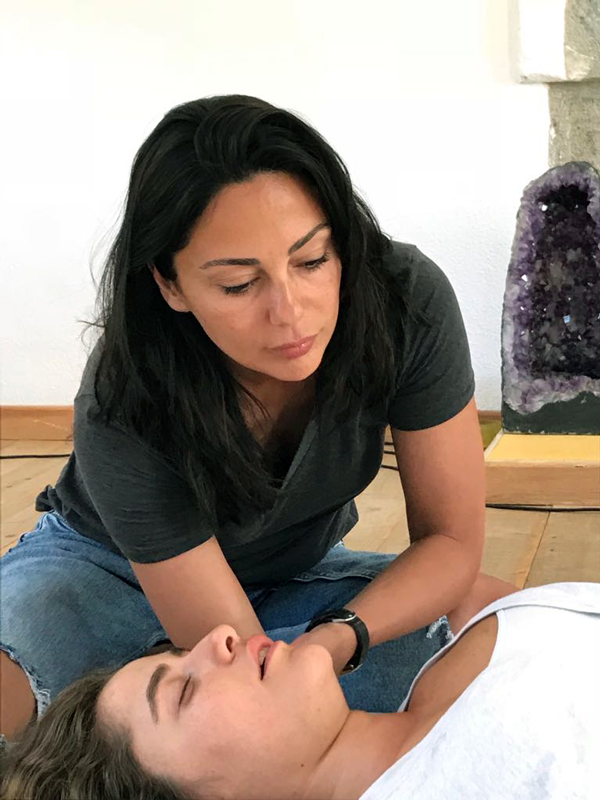Touch is a language of compassion, helping us bond and connect with other humans. It activates the orbitofrontal cortex in the brain, with is linked to feelings of reward and empathy. Tactile stimulation helps to trigger oxytocin, twelve hormones. It lowers cortisol levels, reduces anxiety and stress. It alleviates depression, improves immune function, reduces pain, enhances attentiveness, decreases blood pressure and calms the heart.
What is an SE Touch Session?
SE Touch is a part of Somatic Experiencing (SE), a type of therapy developed to treat trauma and regulate the autonomic nervous system. The SE therapist uses touch to more directly intervene with the client’s nervous system.
How does SE Touch work?
You’ve probably seen a caregiver picking up a crying infant. If the caregiver is calm, the baby inevitably quiets fairly quickly (barring, of course, specific needs like feeding or changing). But if the caregiver is anxious or upset, the infant struggles to calm down.
So in much the same way, the Somatic Experiencing therapist uses her regulated nervous system to help bring regulation back to the client’s nervous system. This happens through an entrainment process between the two nervous systems via touch. With support from the outside, the client’s nervous system can again regain regulation that is responsive to the environment, rather than staying “stuck” in dysregulation. This “stuckness”, frequently a result of trauma, can be on the sympathetic side of the nervous system (e.g. anxiety, panic, etc.), on the parasympathetic side (e.g. depression, shut-down, etc.), or occurring on both sides (e.g. bipolar, medical syndromes, etc.). The goal is flexible and flowing regulation – which is the way the nervous system is designed to work.
What is SE Touch is good for?
- In working with early shock trauma that has a primarily physical origin (particularly when this occurs in the child/infant’s pre-verbal development phase). This is especially true when the client’s symptoms are manifesting as primarily somatic complaints.
- In working with developmental disturbances that have a primarily physical origin, such as extended hospitalizations.
- When it is helpful to the client to learn to differentiate between appropriate, caring touch and inappropriate, harmful touch.
- When touch helps the client integrate his or her change process more fully through all layers of self.
- When touch helps the client remain resourceful in managing his or her activation levels.
- When the use of verbal language is limited, either due to disability or language barriers.
What is Somatic Experiencing (SE)?
Somatic Experiencing was developed by Dr. Peter Levine. He realized that animals complete a full response to a threat, by noticing, reacting and then recovering. What he found was that humans interrupt this response. Animals access and expend these huge amounts of survival energy, they use the energy as fuel to escape the danger. Once they are safe they allow the chemical discharge to move through their nervous systems by allowing their bodies to discharge the remaining energy through trembling, running or shaking which re-sets the mind and body and prepares for the next events. Humans interrupt this process and the energy remains stuck in our bodies, and it keeps replaying in our bodies and minds.
 SE addresses the physiology of stress and trauma by focuses more on the body’s memory of the overwhelming or traumatic event. It is a gentle and slow process that helps “re-set” the nervous system. This holistic approach starts the process of reconnecting the mind and body at a very slow methodical pace in order to create that natural flow that was interrupted by an event or events that was too much, too soon or too fast for our nervous systems to handle. From traumatic events like war, birth traumas, hospitalizations, rape and serious accidents to less obvious events like negative childhood events, being shamed, or feeling different from others interrupt that flow and stay stuck in our bodies.
SE addresses the physiology of stress and trauma by focuses more on the body’s memory of the overwhelming or traumatic event. It is a gentle and slow process that helps “re-set” the nervous system. This holistic approach starts the process of reconnecting the mind and body at a very slow methodical pace in order to create that natural flow that was interrupted by an event or events that was too much, too soon or too fast for our nervous systems to handle. From traumatic events like war, birth traumas, hospitalizations, rape and serious accidents to less obvious events like negative childhood events, being shamed, or feeling different from others interrupt that flow and stay stuck in our bodies.
Anything that threatens our survival can generate PTSD like symptoms.
Somatic Experiencing Touch adds another component to this modality. Helping the nervous system to reorganize and return to a more regulated natural flow. This component is especially effective for the preverbal stage of life. We are unable to store for those events with a narrative, so they remain held as a body memory, manifesting as unexplained anxiety or later in life as a physical symptom. SE touch is also effective in facilitating the completion of thwarted self-protective responses that remain stuck in our bodies. With every event that was too fast or too much for our nervous systems to handle there is a natural self-protective response that wants to complete.
Interested in experiencing SE Touch therapy? Book a Somatic Experiencing session with our practitioners:
Written by:

